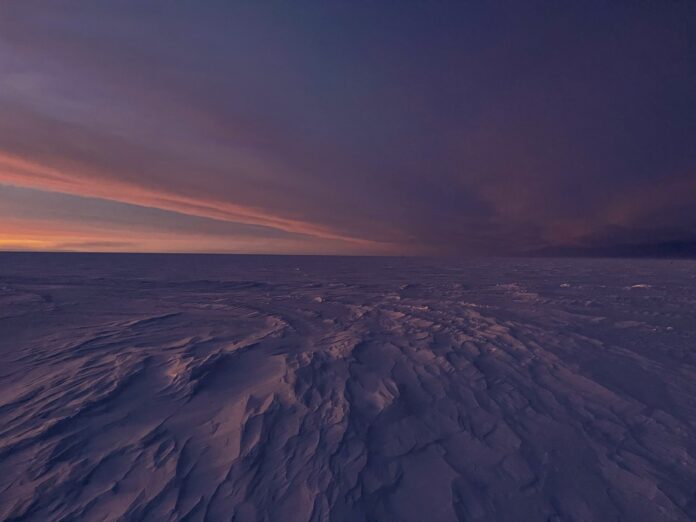An otherworldly view of a snowy landscape in Antarctica has been captured at the South Pole.
The surreal footage taken by Jeff Capps was shared in a viral video from his TikTok account @thejeffcapps. Capps runs the vehicle maintenance shop at the Amundsen-Scott research station at the South Pole and has been working in Antarctica since early 2019, the 33-year-old told Newsweek.
Lending a lunar feel, the video shows the camera moving across a seemingly endless, vast bed of cloud-like snow against the backdrop of a warm pink sky. The sound of snow crunching with each step forward is heard in the background.
Capps told Newsweek: “I shot this video in mid-September, about two weeks before sunrise. The sun only rises once a year at the South Pole so it’s a pretty special time. The snow is so dry because in extreme cold, air cannot hold as much moisture. The snow is made from tiny ice crystals and is very fine.”
A caption shared with the post reads: “This is the sound of the ultra-dry snow crunching at the South Pole.”
Jeff Capps
The Amundsen-Scott South Pole Station is one of three year-round stations operated by the National Science Foundation (NSF). The other two stations are McMurdo Station on Ross Island and Palmer Station on Anvers Island near the Antarctic Peninsula.
The Amundsen-Scott South Pole Station sits at the Earth’s axis, standing at an elevation of 9,306 feet on Antarctica’s “nearly featureless ice sheet,” which is around 9,000 feet thick at that location. The station is drifting with the ice sheet at about 33 feet each year, according to the NSF.
Sunrise at the South Pole is a welcome sight as it follows months of darkness and begins months of sunshine.
The NASA Earth Observatory website explains: “Because Earth’s axis of rotation is tilted with respect to the path of its orbit around the Sun, the North and South Poles experience dramatic seasonal swings in the amount of sunlight they receive.”
Sunrise at a pole is caused by the tilt of the Earth as it orbits the sun, and not by the rotation of the Earth, NASA notes, adding that it can take weeks for the sun to rise at the Earth’s poles, in contrast with hours at any mid-latitude location.
“For six months of the year, the Sun never rises over one pole, and never sets over the other. For scientists braving the winter at the South Pole, the sunrise comes on the September 21-22 equinox,” NASA says, noting that the exact calendar date of the equinox varies.
The annual average temperature at the South Pole station is minus 56 degrees Fahrenheit but monthly averages vary from minus 18 degrees F in December to minus 76 degrees F in July. Snow accumulation is around 20 centimeters (8 inches) per year, with very low humidity, the NSF notes.
Life at the South Pole Like ‘Living on the Moon’
Capps said he shot the latest video while walking and using his phone. Noting it was “very cold” out at minus 85 degrees F (minus 65 degrees Celsius), he said “my phone actually died after just one video as batteries don’t last in the cold.”
Capps started working in Antarctica after he was offered a job there in a chance encounter with a person who runs the vehicle maintenance shop while he was in Denver, Colorado. “We struck up a conversation, I found out he worked in Antarctica and took immediate interest since I like to travel. Next thing you know, I’m quitting my job to go work in Antarctica,” he recalled.
“If I had to sum up what it feels like living at the South Pole, I’d say it’s like a less extreme version of living on the moon. Yeah, we don’t have to wear space suits to go outside, but we get pretty close. The view in every direction is flat and white as far as the eye can see. Our little research station sits alone and it is more than 600 miles to the next closest station,” Capps said.
The biggest challenge of life at the South Pole, as you might expect, are the cold temperatures, he noted. With the average temperature in the winter being minus 76 degrees Fahrenheit, he said “nothing likes to work in the extreme cold.”
Capps explained: “The buttons on my camera freeze, equipment doesn’t start without hours of heat applied, and keeping my fingers warm is a constant battle outside. Fortunately, we don’t have to be outside too much since our research station is warm and well insulated.”
The cold aside, Capps’ favorite part about working at the South Pole is “the gorgeous night sky during the winter,” he said, adding that “the kind and close-knit community is a close second.”
“During the winter, our population is just 43 people. We have no flights in or out from February to late October, so once the plane in February leaves, we’re on our own,” he noted.
Capps hopes the videos he shares through his TikTok and Instagram (@thejeffcapps) accounts will “bring Antarctica to people around the world who don’t have the opportunity to experience it or want to experience its beauty without freezing their butts off.”
‘Looks Like Another Planet’
TikTok users were blown away by the latest viral clip of snow at the South Pole.
Use andrew wrote: “looks like another planet.”
User @adorechelsea_ said: “The sky omg.”
Sam_bne said: “I thought that’s a drone footage.”
🇵🇸 noted: “this sounds SO satisfying.”
Doodle bob wrote: “POV [point of view]: you’re a giant walking over frozen mountain ranges.”
Do you have a travel-related video or story to share? Let us know via [email protected] and your story could be featured on Newsweek.
Uncommon Knowledge
Newsweek is committed to challenging conventional wisdom and finding connections in the search for common ground.
Newsweek is committed to challenging conventional wisdom and finding connections in the search for common ground.


